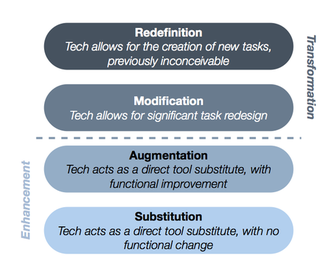|
When I talk about integrating technology to other local teachers whose schools do not have resources, I receive one of two reactions: enthusiastic trepidation or jaded defeat. There is a subtle difference between the two: Teachers who exhibit the first reaction are attracted the the implementation ideas, but worried about whether or not they have the resources and support to execute them. Teachers who respond with the latter attitude are those who have become exhausted by the unending lack of resources and support. They might at one time have been excited by the possibilities technology brings to the classroom, but they are so weary of not having what they need, enthusiasm is not something they can muster even theoretically. One question I hear more than any other on a local level, no matter how individuals react personally, is "Why does your school site seem to have more technology than other sites?" The answer to this question is short and sweet: It seems like we have more because we do. A more productive question to ask is "How did your school site acquire so many technology resources?" The answer to this question is also, at it's heart, short and sweet: We have resources because we have a vision and a plan. Without either one of those, our school would be experiencing a dearth of technology just like many other sites. So, how to you create a vision and where do you get a plan? Establish a committee and get busy. Here are some thoughts about how we did it at my school... Developing a VisionIn order to develop a plan for technology purchasing, you need to have a clear idea of what you want 21st century instruction to look like at your school site. There are many important questions to consider when formalizing this vision:
Authoring a PlanFinding the answers to the philosophical questions will lead you to address the more logistical ones, such as:
Once the logistical questions are answered, a purchasing plan must be developed in order to take a school from being an institution with a theoretical tech plan to an actual one. Developing and executing the purchasing aspect of a school site's technology plan can feel a lot like a wicked game of Tetris. This video pretty much sums it all up: Suggestions to Help You Carry Out a Workable PlanSo, now that you know that planning to purchase technology will more than likely become an ongoing game of monetary Tetris, here are a few recommendations that I can make from personal experience... 1. Budget Creatively and Consult Often Leadership styles and structures seem to vary per site, even within the same district. For example, at my school site there is a leadership team that is representative of all departments on campus, a school site council representative of all the stakeholders, and administration who ultimately juggles the decision-making based on what's best for the students as a whole. The administration at my site appointed Technology Committee members to develop a vision, create a plan, and execute purchasing recommendations for available funds. My husband teaches in the same district and the administration at his site chooses to make the lion's share of the budgetary decisions on campus, running the yearly budget by stakeholders only as a formality. His school site does not have much technology in circulation for general student use, which I think is a testament to the budgetary effectiveness of the leadership style of his administration - at least as far as technology purchasing is concerned. Technology must be made a priority. Allocate funds creatively in order to ensure that tech purchasing is funded. For example, if you have a large population of English Language Learners at your school, then allocate ELAP funds for tech that can be used by this demographic. At a district level, funds may be freed up in the "textbooks" category, since many publishers have online, interactive, or PDF versions of their publications. Grants are always wonderful, but in their absence, you need to get creative. 2. Diversify Your Platform While there are certainly benefits to having students utilize a uniform platform, it is not always necessary. For example, more than one kind of device can utilize Web 2.0 tools, online learning management systems (Edmodo, Schoology), online discussion forums (Today's Meet, Socrative), collaborative cloud spaces (i.e. Google Drive, Dropbox), etc. However, in my experience, when it comes to making movies, podcasting, or doing other tasks higher up on the SAMR Scale of technology implementation, iOS devices are fairly unparalleled. Providing access to adequate amounts of a variety of devices will help you spend your money wisely. If you're not familiar with SAMR, here's a graphic: Realistically, not every teacher operates in the "Redefinition" zone all of the time. Depending on the proficiency level of your staff, you may need more of one type of device than another. Diversifying your platform will make reaching a critical mass of devices more attainable in the short term. Long term, if you would like to strive for creating a 1:1 iOS environment for all students, then you can work on achieving that more gradually. This is not to say that schools should go platform crazy! Quite the opposite - purposefully choose which platforms will best meet the needs of students. Refer back to the technology vision often when making this decision and make conscientious choices. 3. Sustainability is Key A technology plan must include a strategy for sustainability. A certain percentage of the existing technology on campus should (and more than likely, will have to be) replaced every year. There definitely needs to be funding for maintenance, because cords will break, batteries will die, screens will crack, etc. Plus, whatever plan you implement needs to grow the amount of technology on campus each year. Decide to grow and sustain technology simultaneously. If you're dealing with mobile devices, the cost of apps should also be addressed. 4. Roll Out to Advanced Users First If there is technology that is completely new to your school, roll it out to first to advanced technology users - teachers who have already demonstrated excellent competency when implementing educational technology in their classrooms. Set these classrooms up as model classrooms. There are two major benefits to this:
After a reasonable pilot, release the new technology for general use and support teachers as they begin to implement. 5. Don't Forget the P.D. An often overlooked component of effective technology plans is including funds for professional development. When technology stagnates, it is usually because staff do not receive the implementation support they need. Identify on-site experts who can provide training at the district hourly rate, or carefully choose local/regional experts to come in and offer professional development. Conferences can be a good source of ideas, strategies, and professional dialogue. Consider sending delegates to local ed tech conferences, with the caveat that attendees must bring back ideas to present whole-staff.  I've served on the Technology Committee at my school site since it's inception three years ago. This year, I'm also serving on the PSUSD's Technology Committee to provide input as the district Technology Plan is rewritten. I can definitely tell you that there is no "easy" button that will make the process of developing, writing, and executing a technology plan easier. However, you can definitely avoid some problem areas by taking the points in this post into consideration. What things do you think are important to consider when developing a technology plan? Does your school site have a Technology Committee? If so, how does it function? I'd love to continue this conversation, so feel free to comment on this post and/or hit me up on Twitter @Packwoman208. By Jessica Pack
0 Comments
|
Author: Jessica PackCalifornia Teacher of the Year. CUE Outstanding Educator 2015. DIGICOM Learning Teacher Consultant. 6th Grade Teacher. Passionate about gamification, Minecraft, digital story-telling, and fostering student voices. Download:Archives
June 2020
Categories
All
|



 RSS Feed
RSS Feed